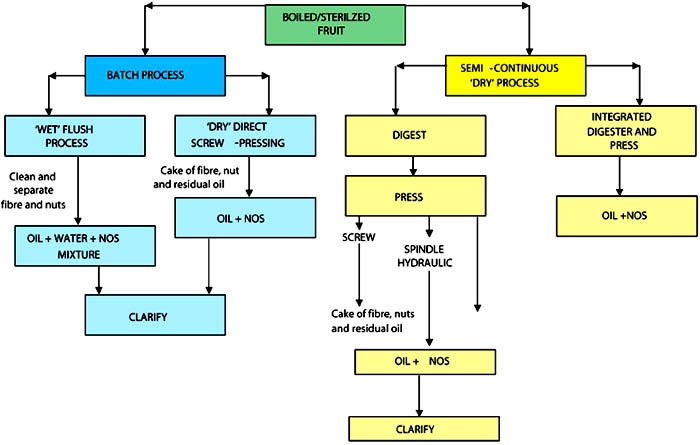How is palm oil made in detail?
FAQ / Chat on line / Give me a price / Date: September 15, 2014
There are two kinds of way to make palm oil. Here we will introduce how palm oil is made in details.

how is palm oil made?
Batch systems
The batch systems work directly on boiled fruit. The oil is extracted from the boiler fruit in one operation for clarification. With a perforated bottom plate to pound a batch of fruit and then flush out the oil and other non-oil solids from the mashed pulp with hot water, the vertical digester is used in‘wet’ method. The direct screw-press is designed to pound a batch of boiled fruit while exerting pressure on the mashed pulp in another section to expel the palm oil in one operation.
The advantage of the wet system is simple and leaches all oil and non oily solid substances completely. The aqueous effluent from the vertical digester goes directly to the clarification stage of processing. The amount of water needed to flush the pulp is normally the same as that required for diluting the viscous oil that comes from the mechanical press in preparation for clarification.
When the wash water is cold, the oil yield by the wet method is reduces. In the course of digesting the fruit mash, in the presence of water, there is increased tendency to form an oil/water emulsion that is difficult to separate from the fibre mass. The emulsified oil loss in the fibre can be substantial if care is not taken to ensure full loading of the digester. Vertical flushing digesters, requiring loading and discharging of a specific amount of material, can thus only be used in a batch operation.
Semi-continuous systems
with one operation feeding directly into another, continuous systems work sequentially related to the arrangement and timing of machine operations. Careful engineering of unit operations is required to minimise discontinuities in the feeding of one stage into another. Otherwise some machines have to be stopped periodically for other stations to catch up. When there are discontinuities in the flow of materials between process stations the operations are known as semi-continuous. The dry extraction systems with separate digestion and pressing stations are usually semi-continuous.
Also when digestion and pressing stations are combined into an integrated unit and there is discontinuous feeding of boiled fruit to the digester inlet the operation is termed “semi-continuous”. Once operations have been integrated to attain full continuity the capital investment capacity of small-scale operators has been surpassed, because both machinery and working capital for raw material increases greatly with the increased level of mechanisation.
The dry systems do not need much water for processing, although they have the disadvantage of leaving substantial residual oil in the press cake. The oil content of the press cake can be quite considerable (2-3 percent), depending on the type of press used and the strength of manual operators.
The efficiency with which the various presses can extract oil ranges from 60 to 70 percent for spindle presses, 80-87 percent for hydraulic presses and 75-80 percent for the Caltech screw-presses. The first-pressing oil extraction rates also range from 12 to 15 percent for the spindle-presses, 14-16 percent for hydraulic presses and 17-19 percent for the motorised screw-presses.
In many instances the first press cake is then sorted to remove the nuts, and the fibre is subsequently subjected to a second pressing to obtain more oil. The second press oil is generally of lower quality, in terms of free fatty acid content and rancidity. Such low-grade oil is used in soap-making. Some village processors undertake the traditional hot water washing of the entire press cake immediately after pressing instead of sorting fibre and second pressing.
Local manufacturers have developed a wide range of machinery and equipment for processing palm oil and palm kernel to fit any budget. All the relevant unit operational machines can be produced to various degrees of finish and quality in the Sub-Region. It is the combination of the unit operation into an affordable process chain that distinguishes the manufacturers and their supplies.
From traditional technologies that rely solely on manual labour and simple cooking utensils, raising the level of mechanization depends largely on a balance between the quantity of bunches available for processing in a given locality and the money available for investment in machines.
The first consideration should be the availability of raw materials and how to compute the processing scale. Knowing the optimum scale of operations, it is then possible to consider the type of processing techniques. The higher the technology, the more skilful operators will be required to handle the machines. These technical considerations should lead to the equipment selection and examination of the capital investments needed to acquire the necessary machines.
The batch type and semi-continuous way are the normal way to get palm oil. There are also another ways to get the palm oil.

how is palm oil made?
Batch systems
The batch systems work directly on boiled fruit. The oil is extracted from the boiler fruit in one operation for clarification. With a perforated bottom plate to pound a batch of fruit and then flush out the oil and other non-oil solids from the mashed pulp with hot water, the vertical digester is used in‘wet’ method. The direct screw-press is designed to pound a batch of boiled fruit while exerting pressure on the mashed pulp in another section to expel the palm oil in one operation.
The advantage of the wet system is simple and leaches all oil and non oily solid substances completely. The aqueous effluent from the vertical digester goes directly to the clarification stage of processing. The amount of water needed to flush the pulp is normally the same as that required for diluting the viscous oil that comes from the mechanical press in preparation for clarification.
When the wash water is cold, the oil yield by the wet method is reduces. In the course of digesting the fruit mash, in the presence of water, there is increased tendency to form an oil/water emulsion that is difficult to separate from the fibre mass. The emulsified oil loss in the fibre can be substantial if care is not taken to ensure full loading of the digester. Vertical flushing digesters, requiring loading and discharging of a specific amount of material, can thus only be used in a batch operation.
Semi-continuous systems
with one operation feeding directly into another, continuous systems work sequentially related to the arrangement and timing of machine operations. Careful engineering of unit operations is required to minimise discontinuities in the feeding of one stage into another. Otherwise some machines have to be stopped periodically for other stations to catch up. When there are discontinuities in the flow of materials between process stations the operations are known as semi-continuous. The dry extraction systems with separate digestion and pressing stations are usually semi-continuous.
Also when digestion and pressing stations are combined into an integrated unit and there is discontinuous feeding of boiled fruit to the digester inlet the operation is termed “semi-continuous”. Once operations have been integrated to attain full continuity the capital investment capacity of small-scale operators has been surpassed, because both machinery and working capital for raw material increases greatly with the increased level of mechanisation.
The dry systems do not need much water for processing, although they have the disadvantage of leaving substantial residual oil in the press cake. The oil content of the press cake can be quite considerable (2-3 percent), depending on the type of press used and the strength of manual operators.
The efficiency with which the various presses can extract oil ranges from 60 to 70 percent for spindle presses, 80-87 percent for hydraulic presses and 75-80 percent for the Caltech screw-presses. The first-pressing oil extraction rates also range from 12 to 15 percent for the spindle-presses, 14-16 percent for hydraulic presses and 17-19 percent for the motorised screw-presses.
In many instances the first press cake is then sorted to remove the nuts, and the fibre is subsequently subjected to a second pressing to obtain more oil. The second press oil is generally of lower quality, in terms of free fatty acid content and rancidity. Such low-grade oil is used in soap-making. Some village processors undertake the traditional hot water washing of the entire press cake immediately after pressing instead of sorting fibre and second pressing.
Local manufacturers have developed a wide range of machinery and equipment for processing palm oil and palm kernel to fit any budget. All the relevant unit operational machines can be produced to various degrees of finish and quality in the Sub-Region. It is the combination of the unit operation into an affordable process chain that distinguishes the manufacturers and their supplies.
From traditional technologies that rely solely on manual labour and simple cooking utensils, raising the level of mechanization depends largely on a balance between the quantity of bunches available for processing in a given locality and the money available for investment in machines.
The first consideration should be the availability of raw materials and how to compute the processing scale. Knowing the optimum scale of operations, it is then possible to consider the type of processing techniques. The higher the technology, the more skilful operators will be required to handle the machines. These technical considerations should lead to the equipment selection and examination of the capital investments needed to acquire the necessary machines.
The batch type and semi-continuous way are the normal way to get palm oil. There are also another ways to get the palm oil.



